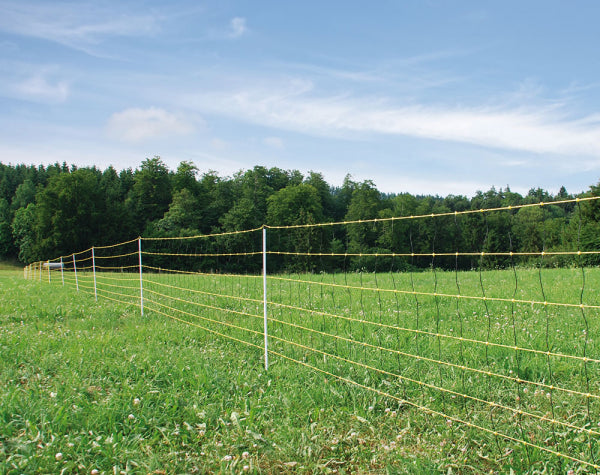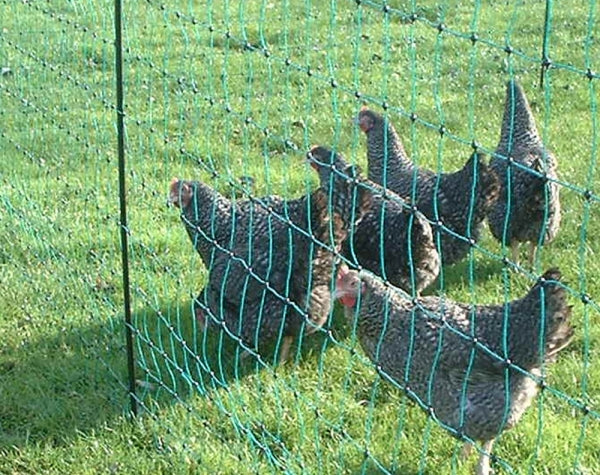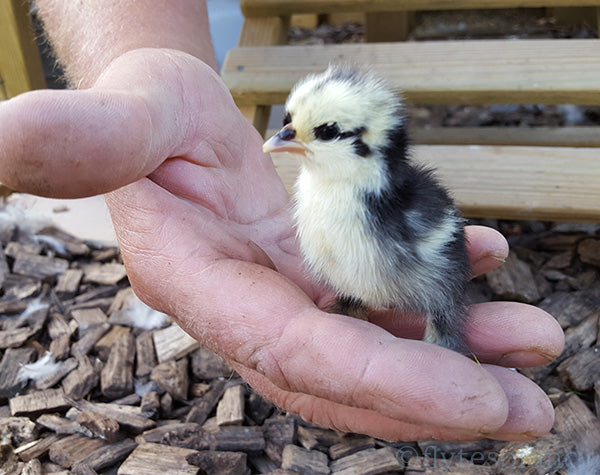Your Electric Fencing Questions Answered
Does the Electric Poultry Netting really keep the fox out even though it is only 3 ft 6 in (1.1m) high?
Yes, it does. Electric Poultry Netting is to keep the foxes out, not necessarily to keep the chickens in i.e. some birds may be more flighty than others, and they may fly out of the pen. If so, you will probably need to clip one wing, that is, trim the leading flight feathers to make them feel unbalanced.
A fox would not leap over a one-metre tall fence unless it has something to climb on to first. Foxes tend to 'scramble' over fences not 'leap' over them so if you want a non-electric fence around your chickens it would need to be over 6ft tall.
It is wise to just check the perimeter of your planned fence and 'think like a fox' to make sure there would be no easy access points or things to climb onto (including low trees).
The fox (or badger) will investigate the fence you have placed around his dinner, looking for the easy way in, and then it will 'bite' him. He will wander off to look for easier prey and come back another night in case you haven't switched the fence on.
For more guidance visit our How to Install Electic Fencing page or the How Electric Fencing Works page.
Can I use electric netting with Ducks and Geese?
We would not advise this form of fencing for ducks and geese. We learnt this many years ago when we lost both ducks and geese that had become entangled in netting.
Waterfowl have a tendency to try and walk through the flexible netting for some reason; they don't see it as an obstruction and then cannot get free. For waterfowl, we advise either wooden or plastic posts and then insulators to carry either tape or wire in a more rigid way so they cannot become entangled.
How does the animal get a shock?
The animal must have its feet (or some part of its body) on the ground to receive a shock. This is because the electric pulse going through the fence (positive) will give a shock only if it can go to earth (negative) and it will do this through the animal, or human (unless you are insulated from the ground by wellies for example).
The more contact the animal has with the ground the greater shock he will feel, so, a fox or badger with large soft paws will get a greater shock than a goat for example who has small hooves.
I have pets and children; will the electric fence hurt them?
No, the pets will undoubtedly yelp if they come into contact with it, and run away, but it won't physically hurt them (although they may not speak to you for a few days).
The only potential danger posed by an electric fence is if a small animal becomes entangled in it for several hours and cannot get free, then it could harm them. Most 'pet deterrent' kits are very low voltage though and pose no danger at all.
Children of course will love the tingle they get and find it great fun! Then you will have to stop them playing with it. Children are easier to tell about it than pets so the answer is to make sure they understand that they should not touch the fence.
It is always advisable to have an electric fence warning sign even if your fence cannot be accessed by the general public. The only time there is any danger to people is if they have a pacemaker fitted, otherwise, it will just make you jump and maybe do a little dance. But it is not advisable, from a common-sense point of view, to keep touching the fence or to encourage anyone else to touch a live fence.
Why do I need an earth stake?
The Earth Stake, or Ground Rod, is essential to make the system work and should be pushed well into damp ground. This will complete the circuit between the fence, the animal and the energiser.
The electric pulse goes through the fence, through the animal, to the ground, back to the earth stake, which is connected to the energiser - and that completes the 'electrical circuit'.
I've set it all up but it doesn't work, why?
- Make sure all the connections to the earth stake and to the fence are sound and good, and that all wires are unbroken.
- Is it switched on? You would be amazed how many people forget this part.
- Are the batteries new? If using a 12v battery is it fully charged? If using normal D Batteries, do not use rechargeables as they drain very quickly and are not recommended.
- Do not tie the tape/wire in a knot to finish or join ends as this will impede the electrical conductivity. Use metal buckles for tape and polywire connectors for wires.
- Make sure there is NO vegetation (or anything else) touching the tape/wire to make it short out to earth.
- You can call us of course for any advice about making it work, but please just double check the installation instructions again - please!
I have a car battery; can I just connect it to the fence?
No, you need an energiser to convert the stored energy in the battery into an electrical pulse that the fence can recognise.
There seem to be a lot of different energisers, how do I decide which one I need for my fence?
Firstly, add up how long your fence will be, not forgetting that if you have four strands in your fence for example, you must then multiply the length by four.
There are guidelines within the specifications of all the energiser details to tell you how much fence length it will power. If still in doubt just give us a call.
What is the difference between a mains and battery powered energiser, and how do they work?
Put simply, the energiser (fencer) takes the power from a mains socket and converts it to a DC voltage to pulse through the fence. With a battery system the battery (usually 12v car-type battery) becomes your power source and it again uses the stored power of the battery to send a pulse through the fence. As a guide a mains energiser will put a more consistent, usually higher, voltage through the fence.
How do I decide between a battery and a mains system?
A mains system is a preferable system because you don't have to worry about the battery going flat, it costs very little to run and is usually less expensive to set up initially. You can place your energiser up to 50m, maybe 100m, from the fence itself and connect with an insulated lead-out cable.
A battery system is the best idea if you require more flexibility and need to move the fence frequently, or maybe mains power is simply not available where the fence is situated.
There are Dual Power Fence Energisers e.g. Hotline Gemini available so that it covers both options from one energiser should requirements change for you.
How often will I need to re-charge the 12v battery?
We would always recommend using a 12v Leisure Battery (used in caravans and motorboats) in preference to a car battery, as this type will last longer and give a better voltage over time.
We would recommend re-charging with a car battery charger, preferably a 7 amp if possible, every 2-3 weeks (depending on the draw of fence). A 12v Leisure Battery should not be allowed to drop below 50%-60% charge as it will then be difficult to get the battery to take a full charge again. This will make sure your battery stays in good condition for a number of years, and that the plates inside will not be damaged.
Can I re-charge a 9v or 6v battery?
No. the 6v batteries and 9v Batteries are disposable so would need to be replaced.
Will some grass growing around my fence stop it working?
It certainly could do. The ideal is that no grass or any vegetation - bushes, trees, timber posts or anything except plastic - touches the electric wires. If it does, it will conduct the voltage from the fence to the ground and therefore reduce the voltage going through the fence.
If there is a shorting out you would be able to hear a 'clicking' noise from the fence and this will indicate that there is a short somewhere. You would not normally hear any noise from the fence apart from a very faint ticking or hum from the energiser.
If you think vegetation is going to be a problem then you can strim or mow where the fence is to go, or, use a higher-powered energiser so that some loss of voltage is less important.
I have a fence tester, but how many volts should it show going through my fence?
With electric netting we would suggest a reading of 3000v would be great, and 2000v is fine. The voltage of the fence will depend on the power of the energiser of course.
The voltage required also depends on which animal(s) you are fencing in or out. Cattle for example, with their tough hides, will need a higher voltage (say, 6000v) than foxes who investigate with their noses. The KV10 Self Earthing Tester would give an easy-to-read voltage measurement.
I want to keep cats/foxes out of my garden, they climb over a 5ft tall fence, how can I do this?
You need to make a two-strand fence running in parallel, along the top of your fence, with the lines of wire approx 2" apart. Or try our 30m Garden Fence Kit.
One wire will be a live wire and the other an earth wire. You would need some screw-in insulators and then a polywire to use as both your live and earth wires.
A simple low voltage energiser will do the job and should be connected to one wire strand, and the other wire strand would be connected to your earth stake. The idea is that the cat (or fox) would touch both wires at the same time and therefore receive a shock.



